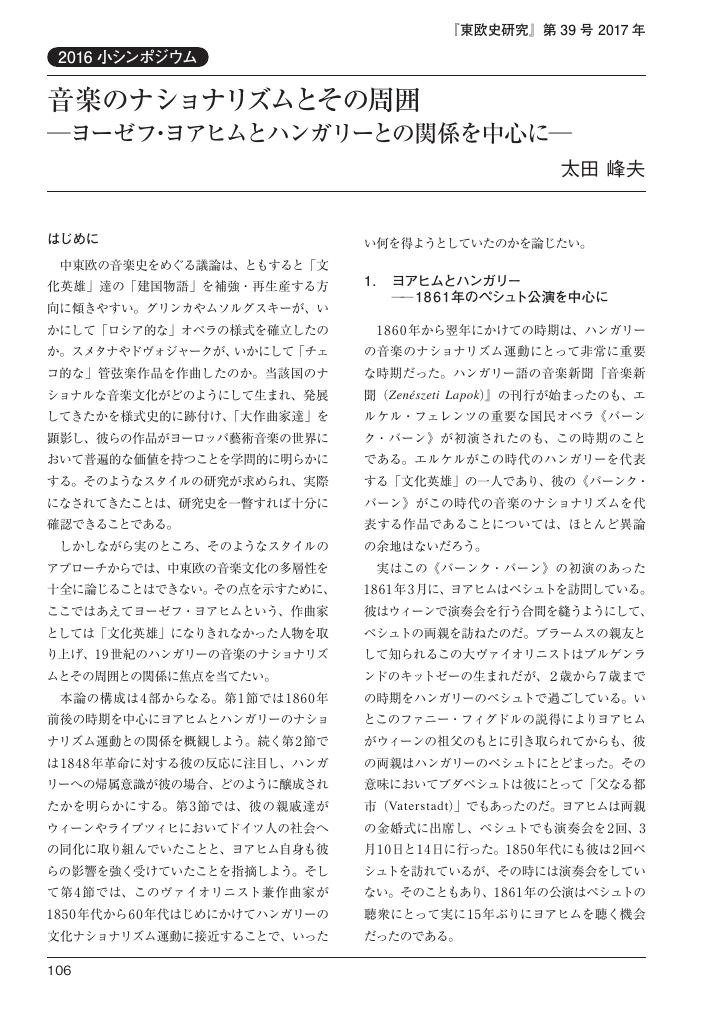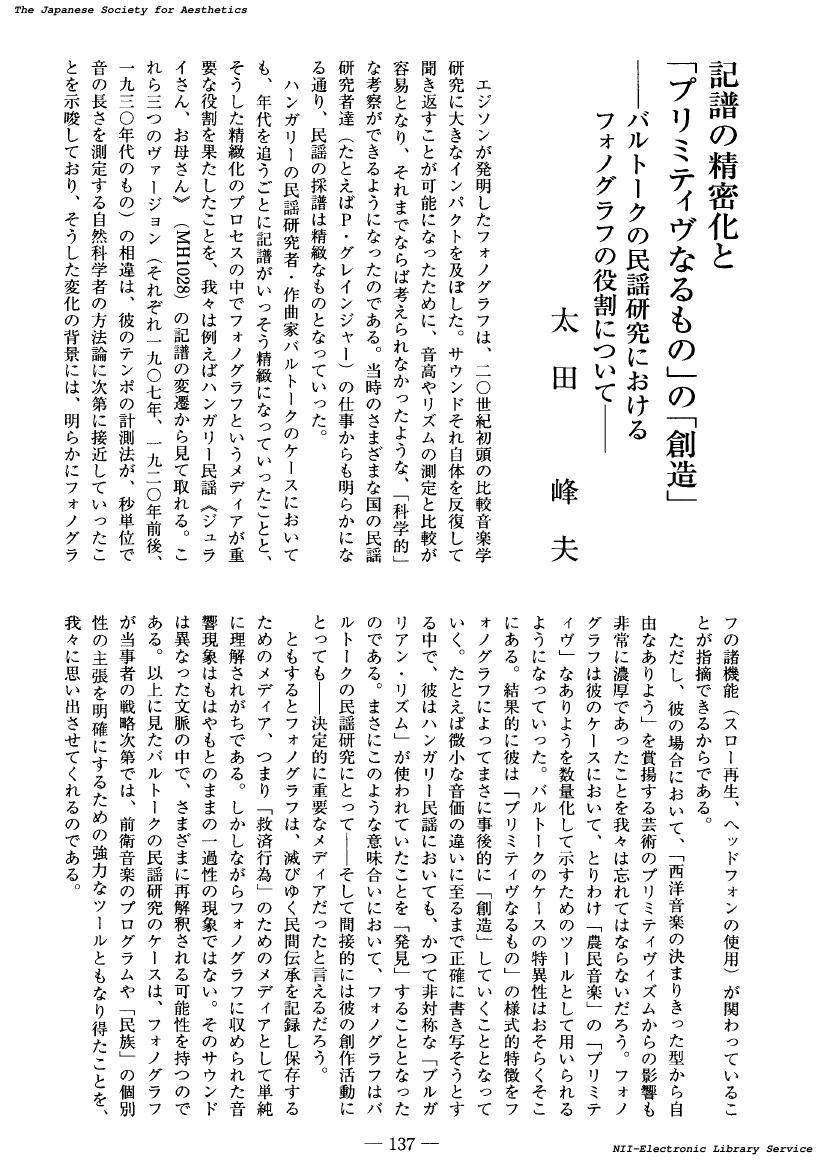5 0 0 0 OA 「生活場所(ビオトープ)」の美学-自然・環境・美的文化
- 著者
- 西村 清和 尼ヶ崎 彬 長野 順子 相澤 照明 山田 忠彰 中川 真 渡辺 裕 津上 英輔 青木 孝夫 外山 紀久子 大石 昌史 小田部 胤久 安西 信一 椎原 伸博 上村 博 木村 建哉 上石 学 喜屋武 盛也 東口 豊 太田 峰夫
- 出版者
- 東京大学
- 雑誌
- 基盤研究(A)
- 巻号頁・発行日
- 2007
本研究は従来自然美論、風景論、環境美学、都市美学という評語のもとで考えられてきたさまざまな具体的、個別的諸問題領域を、日常生活の場において企てられたさまざまな美的実践としてとらえなおし、あらたな理論化を目指すものである。具体的には風景、都市景観、森林、公園、庭園、人工地盤、観光、映画ロケ地、遊芸、雨(天候)、清掃アートなど多様な現象をとりあげて分析し、その成果を『日常性の環境美学』(勁草書房、2012)として刊行した。
4 0 0 0 OA 旧東欧地域における「演歌型」大衆音楽の比較研究
ブルガリアの「チャルガ」は、「マネレ」(ルーマニア)、「ターボフォーク」(旧ユーゴ諸国)などのポップフォーク(民俗的大衆音楽)と並んで、1990年代以降バルカン諸国に特有の社会現象であり、同様の現象は日本の「演歌」をはじめとしてアジア各国にも見られる。本研究はそれら諸ジャンルの比較を行い、その類似と差異をあきらかにすることを目指してきた。これまでに大阪、東京などの諸都市で、8回の研究会を開催し、20の報告が行われた。2017年にはこの問題に関する国際会議を開催する予定である。そこでは上記諸ジャンルの社会的文脈を検証し、歌詞や音楽構造の分析が行われた。日本語による単行本出版が準備されている。
- 著者
- 太田 峰夫
- 出版者
- 美学会
- 雑誌
- 美學 (ISSN:05200962)
- 巻号頁・発行日
- vol.53, no.2, pp.39-52, 2002-09-30
In his mature years Bela Bartok continuously argued that the influence of peasant music on art music should be realized by grasping its "spirit"-which penetrates the composer's creativity. We usually take this argument simply as a part of his program for modernist music, but the significance of this "spirit" remains hardly convincing. It is unclear why modern musicians should undertake such a demanding task as to make the "spirit" of peasant music their own. We can clarify the importance of this idea solely by considering the historical background of Hungary. The discourse of the "spirit" of peasant music can be related to the nationalistic movement from the first decade of the twentieth century ; especially to the innovatively minded movement led by young intellectuals such as Endre Ady. Under the influence of social radicalism, they began to seek the new cultural identity of Hungary. Precisely according to this new trend Bartok also formulated his strategy, approaching long-forgotten cultures of the peasant class and of other peoples. Because of this political-cultural context it became his ultimate goal to grasp the "spirit" of peasant music, which could justify his artistic endeavor both in the nationalistic context and in the modernist one.
1 0 0 0 OA 農民音楽の「精神」は何故重要なのか : バルトークの民俗音楽観とその歴史的背景について
- 著者
- 太田 峰夫
- 出版者
- 美学会
- 雑誌
- 美学 (ISSN:05200962)
- 巻号頁・発行日
- vol.53, no.2, pp.39-52, 2002-09-30 (Released:2017-05-22)
In his mature years Bela Bartok continuously argued that the influence of peasant music on art music should be realized by grasping its "spirit"-which penetrates the composer's creativity. We usually take this argument simply as a part of his program for modernist music, but the significance of this "spirit" remains hardly convincing. It is unclear why modern musicians should undertake such a demanding task as to make the "spirit" of peasant music their own. We can clarify the importance of this idea solely by considering the historical background of Hungary. The discourse of the "spirit" of peasant music can be related to the nationalistic movement from the first decade of the twentieth century ; especially to the innovatively minded movement led by young intellectuals such as Endre Ady. Under the influence of social radicalism, they began to seek the new cultural identity of Hungary. Precisely according to this new trend Bartok also formulated his strategy, approaching long-forgotten cultures of the peasant class and of other peoples. Because of this political-cultural context it became his ultimate goal to grasp the "spirit" of peasant music, which could justify his artistic endeavor both in the nationalistic context and in the modernist one.
1 0 0 0 OA 音楽のナショナリズムとその周囲 ─ヨーゼフ・ヨアヒムとハンガリーとの関係を中心に─
- 著者
- 太田 峰夫
- 出版者
- 東欧史研究会
- 雑誌
- 東欧史研究 (ISSN:03866904)
- 巻号頁・発行日
- vol.39, pp.106-111, 2017 (Released:2022-02-12)
- 著者
- 太田 峰夫
- 出版者
- 美学会
- 雑誌
- 美学 (ISSN:05200962)
- 巻号頁・発行日
- vol.62, no.1, pp.121-132, 2011-06-30 (Released:2017-05-22)
In the first half of the 20^<th> century many musicologists tried to notate folk songs precisely by the help of recording media. In the case of Bela Bartok we can see that his notation of folk songs became more and more detailed as his career progressed. It is certain that the phonograph played an important role in this change in notation, even though several other factors such as the spread of "audile technique" for concentrative listening also could have been important as well. While Bartok believed that the track of record was the most authentic record of songs, he continued to use the traditional way of notation with additional signs. Consequently, aided by a phonograph with a headset, he could "discover" such unknown stylistic features as "Bulgarian rhythm" that might enlarge the vocabulary of traditional European art music. Considering his notion of "Bulgarian rhythm" as "common character of south eastern European folk music" on one hand, and the frequent appearance of "Bulgarian rhythm" with Hungarian stylistic features in his works on the other, perhaps we may say that phonograph contributed not only to his scholarly activity but also-if indirectly-to his modernist creative activity.
1 0 0 0 OA 記譜の精密化と「プリミティヴなるもの」の「創造」 : バルトークの民謡研究におけるフォノグラフの役割について(分科会IV-B[音楽のモダニズム],研究発表IV,第六十回美学会全国大会報告発表要旨)
- 著者
- 太田 峰夫
- 出版者
- 美学会
- 雑誌
- 美学 (ISSN:05200962)
- 巻号頁・発行日
- vol.60, no.2, pp.137, 2009-12-31 (Released:2017-05-22)
1 0 0 0 IR 「真正性」の構造――「古楽運動」において「過去への忠実さ」が果たす役割について
- 著者
- 太田 峰夫
- 出版者
- 国士舘大学哲学会
- 雑誌
- 国士舘哲学 (ISSN:13432389)
- 巻号頁・発行日
- vol.17, 2013-03
1 0 0 0 『ジプシーとハンガリーにおける彼らの音楽について』(1859年)におけるリスト・フェレンツのツィンバロム観について : 作曲家リストと19世紀後半の普及運動との関係をめぐる一考察 (民族藝術学の諸相)
- 著者
- 太田 峰夫
- 出版者
- 民族芸術学会
- 雑誌
- 民族芸術 (ISSN:09111107)
- 巻号頁・発行日
- vol.33, pp.195-201, 2017

